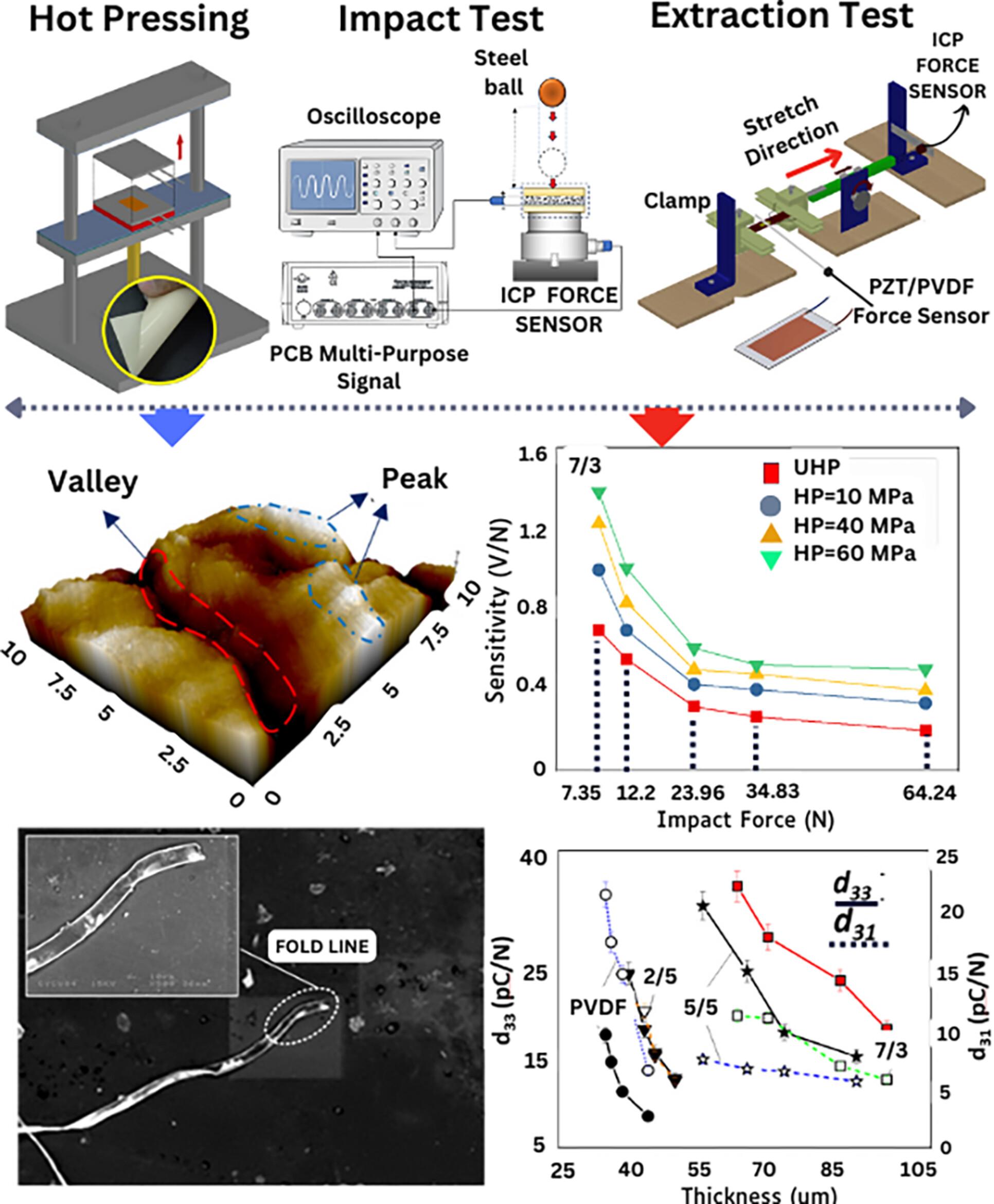Fabrication and characterization of PZT/PVDF composite films for force sensor applications
Suprapto, Yung Ting, Hariyanto Gunawan, Edwar Yazid, Aditya Sukma Nugraha, Budi Azhari, M Luthfi Ramadiansyah, M Fathul Hikmawan, Jubaidah
求助PDF
{"title":"Fabrication and characterization of PZT/PVDF composite films for force sensor applications","authors":"Suprapto, Yung Ting, Hariyanto Gunawan, Edwar Yazid, Aditya Sukma Nugraha, Budi Azhari, M Luthfi Ramadiansyah, M Fathul Hikmawan, Jubaidah","doi":"10.1002/pi.6643","DOIUrl":null,"url":null,"abstract":"<p>This study explored the impact of hot press parameters on lead zirconate titanate (PZT)/poly(vinylidene fluoride) (PVDF) composite films designed for force-sensing applications. The systematic fraction (PZT/PVDF), pressure, temperature, and time during hot pressing processes are subject to variation. The focus is on the resulting composite film thickness and its subsequent influence on the piezoelectric properties, which are essential for the performance of force sensors. The present study investigated the characteristics and performance of PZT/PVDF composite films with fraction ratios 2/5, 5/5, and 7/3 and hot pressure of 10, 40, and 60 MPa and temperature at 150 °C for 2 h. The characterization of these films was conducted using X-ray diffraction, Fourier transform infrared spectroscopy, atomic force microscopy, and scanning electron microscopy. The piezoelectric properties (<i>d</i><sub>33</sub> and <i>d</i><sub>31</sub>) were measured using impact and extraction tests to evaluate the performance of films with applied forces. The results show that the highest piezoelectric coefficients (<i>d</i><sub>33</sub> and <i>d</i><sub>31</sub>) were determined to be 35.8 and 12.60 pC N<sup>−1</sup>, with fraction ratios of 7/3 and 2/5. The study revealed a positive correlation between the PZT/PVDF ratio and sensitivity, indicating that an increase in the ratio leads to an increase in sensitivity. Conversely, a negative relationship was observed between the impact load and the sensor sensitivity, suggesting that an increase in the impact load results in a sensitivity decrease. The results of this work demonstrate the great potential of piezoelectric PZT/PVDF composite films in force sensors for small load applications. © 2024 Society of Chemical Industry.</p>","PeriodicalId":20404,"journal":{"name":"Polymer International","volume":"73 9","pages":"727-747"},"PeriodicalIF":2.9000,"publicationDate":"2024-04-24","publicationTypes":"Journal Article","fieldsOfStudy":null,"isOpenAccess":false,"openAccessPdf":"","citationCount":"0","resultStr":null,"platform":"Semanticscholar","paperid":null,"PeriodicalName":"Polymer International","FirstCategoryId":"92","ListUrlMain":"https://onlinelibrary.wiley.com/doi/10.1002/pi.6643","RegionNum":4,"RegionCategory":"化学","ArticlePicture":[],"TitleCN":null,"AbstractTextCN":null,"PMCID":null,"EPubDate":"","PubModel":"","JCR":"Q2","JCRName":"POLYMER SCIENCE","Score":null,"Total":0}
引用次数: 0
引用
批量引用
Abstract
This study explored the impact of hot press parameters on lead zirconate titanate (PZT)/poly(vinylidene fluoride) (PVDF) composite films designed for force-sensing applications. The systematic fraction (PZT/PVDF), pressure, temperature, and time during hot pressing processes are subject to variation. The focus is on the resulting composite film thickness and its subsequent influence on the piezoelectric properties, which are essential for the performance of force sensors. The present study investigated the characteristics and performance of PZT/PVDF composite films with fraction ratios 2/5, 5/5, and 7/3 and hot pressure of 10, 40, and 60 MPa and temperature at 150 °C for 2 h. The characterization of these films was conducted using X-ray diffraction, Fourier transform infrared spectroscopy, atomic force microscopy, and scanning electron microscopy. The piezoelectric properties (d 33 and d 31 ) were measured using impact and extraction tests to evaluate the performance of films with applied forces. The results show that the highest piezoelectric coefficients (d 33 and d 31 ) were determined to be 35.8 and 12.60 pC N−1 , with fraction ratios of 7/3 and 2/5. The study revealed a positive correlation between the PZT/PVDF ratio and sensitivity, indicating that an increase in the ratio leads to an increase in sensitivity. Conversely, a negative relationship was observed between the impact load and the sensor sensitivity, suggesting that an increase in the impact load results in a sensitivity decrease. The results of this work demonstrate the great potential of piezoelectric PZT/PVDF composite films in force sensors for small load applications. © 2024 Society of Chemical Industry.
用于力传感器应用的 PZT/PVDF 复合薄膜的制作与表征
本研究探讨了热压参数对设计用于力传感应用的 PZT/PVDF 复合薄膜的影响。在热压过程中,热压过程中的系统组分(PZT/PVDF)、压力、温度和时间都会发生变化。重点在于所产生的复合薄膜厚度及其对压电特性的影响,而压电特性对力传感器的性能至关重要。本研究采用 X 射线衍射 (XRD)、傅立叶变换红外光谱 (FTIR)、原子力显微镜 (AFM) 和扫描电子显微镜 (SEM) 对这些薄膜进行了表征。压电特性(d33 和 d31 常数)的测量采用冲击和萃取试验,以评估薄膜对外加力的性能。结果表明,最高压电系数(d33 和 d31)分别为 35.8 pC/N 和 12.60 pC/N,分数比分别为 7/3 和 2/5。研究显示,PZT/PVDF 比率与灵敏度之间存在正相关关系,表明比率增加会导致灵敏度增加。相反,冲击载荷与传感器灵敏度之间呈负相关,表明冲击载荷增加会导致灵敏度下降。这项工作的结果证明了压电 PZT/PVDF 复合薄膜在小负载应用的力传感器中的巨大潜力。本文受版权保护。
本文章由计算机程序翻译,如有差异,请以英文原文为准。



